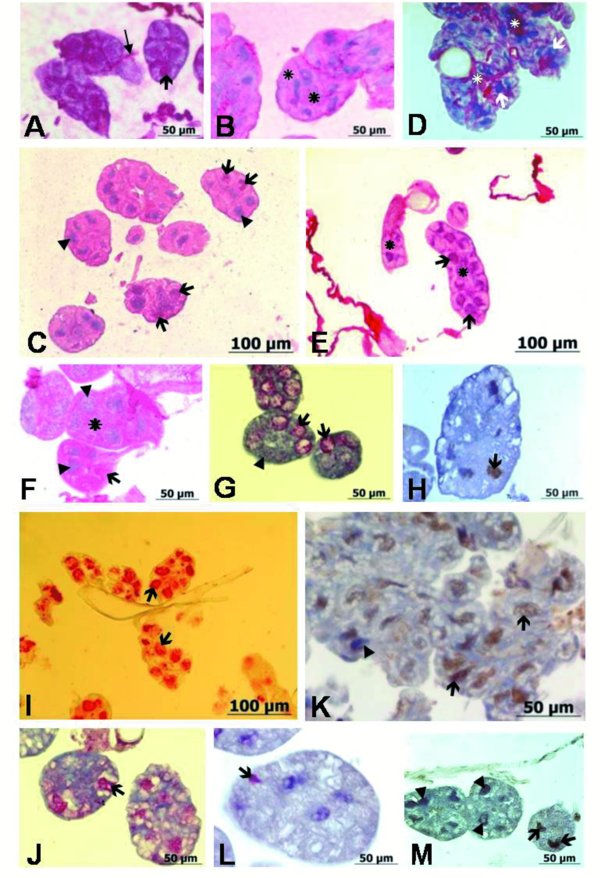Figure 3

A-M. A. 2 day old worker bee after 24 h of imidacloprid treatment. Staining with Hsp 70 monoclonal antibody. Red azo-dye reaction product dispersed throughout the cytoplasm, cell nuclei (212) and ducts (221) in glandular cells. B. 6 day old worker bee after 24 h of imidacloprid treatment. Staining with Hsp 90 monoclonal antibody. Activity found in cytoplasm (107). C. HPG of 9 day old bee after 48 h of coumaphos treatment with sporadic Hsp 70 positive nuclei (212). Note negative nuclei (H). D. 20 day old bee after 48 h of coumaphos treatment. Staining with Hsp 70 monoclonal antibody. Fast red reaction product is diffused throughout the cell cytoplasm (107) and nuclei remain Hsp 70 negative (212). E. 4 day old untreated worker bee. Staining with Hsp 90 monoclonal antibody. Fast red reaction product is diffused throughout the cytoplasm (107), and in the nuclei (212). F. 12 day old untreated bee. Staining with Hsp 70 monoclonal antibody. Fast red reaction product is diffused throughout the cell cytoplasm (107), and in sporadic nuclei (212) of HPG cells. Note negative cell nuclei (H). G. 4 day old bee after 48 h of imidacloprid treatment. Cell death was detected by the TUNEL technique using terminal deoxynucleotidyl transferase (TdT)-mediated dUTP for DNA labelling, and anti-fluorescein alkaline phosphatase conjugated antibody (ISCDDK), fast red was used for visualization, and counterstaining with haematoxylin. The figure shows dense red azo-dye staining localised to the nuclei (212) of the glandular cells. Note some negative cell nuclei (H). H. 6 day old bee after 48 h of imidacloprid treatment. Staining of formalin-fixed, paraffin-embedded HPG and the terminal deoxynucleotidyl transferase (TdT) mediated dUTP nick end labelling (TUNEL) technique using ”ApopTag” kit. Peroxidase conjugated anti-digoxigenin secondary antibody and DAB as a substrate were used to obtain specific brown reaction product. DAB reaction product is localised in sporadic cell nuclei (212). I. 7 day old bee after 72 h of imidacloprid treatment, with all dense red azo-dye staining localised to the nuclei (212). J. 11 day old bee after 48 h of coumaphos treatment. Cell death was detected by the TUNEL technique (ISCDDK). Dense red azo-dye staining localised to the nuclei (212). K. 21 day old bee after 72h of coumaphos treatment. ApopTag kit indicates DAB positive cell nuclei (212) characteristic for cell death in the HPG. Note sporadic non apoptotic cell (H). L. 15 day old untreated bee. Cell death was detected by the TUNEL technique (ISCDDK). Dense red azo-dye staining localised to the sporadic nuclei (212). M. 2 day old untreated bee. DAB reaction product is localised in sporadic cell nuclei (212). Note negative nuclei (H).


